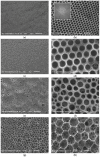Controlled ATRP Synthesis of Novel Linear-Dendritic Block Copolymers and Their Directed Self-Assembly in Breath Figure Arrays
- PMID: 30960523
- PMCID: PMC6473431
- DOI: 10.3390/polym11030539
Controlled ATRP Synthesis of Novel Linear-Dendritic Block Copolymers and Their Directed Self-Assembly in Breath Figure Arrays
Abstract
Herein, we report the formation and characterization of novel amphiphilic linear-dendritic block copolymers (LDBCs) composed of hydrophilic dendritic poly(ether-ester), PEE, blocks and hydrophobic linear poly(styrene), PSt. The LDBCs are synthesized via controlled atom transfer radical polymerization (ATRP) initiated by a PEE macroinitiator. The copolymers formed have narrow molecular mass distributions and are designated as LGn-PSt Mn, in which LG represents the PEE fragment, n denotes the generation of the dendron (n = 1⁻3), and Mn refers to the average molecular mass of the LDBC (Mn = 3.5⁻68 kDa). The obtained LDBCs are utilized to fabricate honeycomb films by a static "breath figure" (BF) technique. The copolymer composition strongly affects the film morphology. LDBCs bearing acetonide dendron end groups produce honeycomb films when the PEE fraction is lower than 20%. Pore uniformity increases as the PEE content decreases. For LDBCs with hydroxyl end groups, only the first generation LDBCs yield BF films, but with a significantly smaller pore size (0.23 μm vs. 1⁻2 μm, respectively). Although higher generation LDBCs with free hydroxyl end groups fail to generate honeycomb films by themselves, the use of a cosolvent or addition of homo PSt leads to BF films with a controllable pore size (3.7⁻0.42 μm), depending on the LDBC content. Palladium complexes within the two triazole groups in each of the dendron's branching moieties can also fine-tune the morphology of the BF films.
Keywords: ATRP; amphiphilic; breath figure; linear-dendritic copolymer; self-assembly.
Conflict of interest statement
The authors declare no conflict of interest.
Figures















References
-
- Yu B., Cong H., Li Z., Yuan H., Peng Q., Chi M., Yang S., Yang R., Wickramasinghe S.R., Tang J. Fabrication of highly ordered porous membranes of cellulose triacetate on ice substrates using breath figure method. J. Polym. Sci. Part B Polym. Phys. 2015;53:552–558. doi: 10.1002/polb.23667. - DOI
Grants and funding
LinkOut - more resources
Full Text Sources
Miscellaneous

